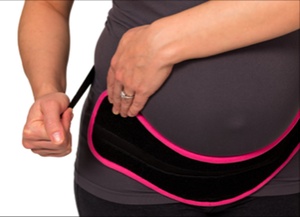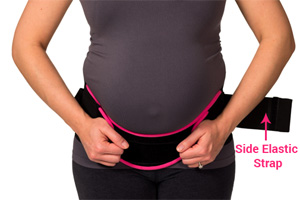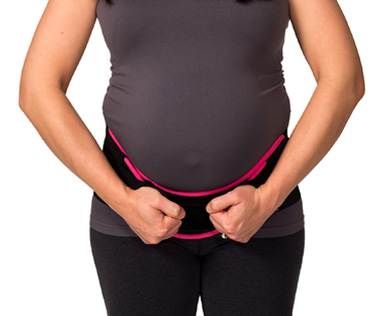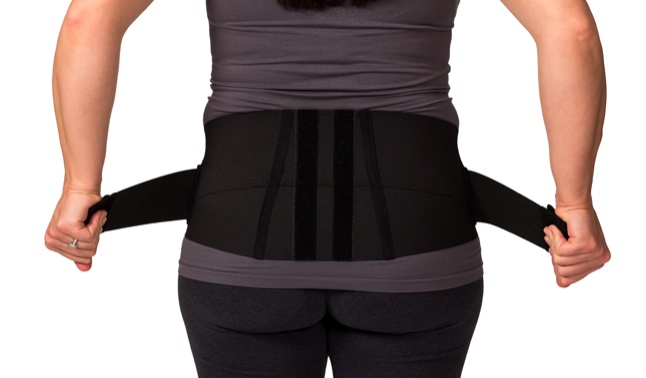Follow these simple instructions and watch the video to determine exactly where you need support from the Baby Belly Pelvic Support™. Remember, where you need support can change throughout your pregnancy so come back to the hug & squat test to ensure you are wearing it right.
1. Wrap and attach

Wrap and attach the pink-trimmed belly support piece around your low abdomen
2. Wrap the elastic pelvic support


Wrap the large elastic pelvis support piece (leave the side straps free) around your pelvis holding only the pink ends. Pull both ends forward and attach this piece to the front belly support piece. It should provide a snug fit as if your pelvis is ‘hugged’.
3. Where to attach the elastic straps
This step determines where to attach the elastic side straps. Push your hip bones together at the front of your pelvis and do a small squat (see below). Now push your hip bones together at the back of your pelvis and do a small squat (see below). Which feels better?


If the way on the left feels best, apply the elastic straps to the front (step 5). If the way on the right feels best, apply the elastic straps to the back (step 5).
4. Fold the clothing protector
Before attaching the side straps to the front or back, fold the clothing protector over the Velcro on what will be the outside of the strap to prevent your clothes from sticking to the Velcro.

Before attaching the side straps to the front or back, fold the clothing protector over the Velcro on what will be the outside of the strap to prevent your clothes from sticking to the Velcro.
5. Front support or back support
For Front Support: Pull side straps forward and attach to the belly support piece.


For Back Support: Pull side straps back and attach to the pelvis support piece.


When to wear the Baby Belly Pelvic Support™
There are no hard and fast rules for this, it really depends on how much support your belly and pelvis needs. If you are waking with pain try wearing it when you sleep. As your pregnancy advances you may find you need to wear it more and more, that’s OK your muscles will not weaken as long as you continue to exercise and do not just ‘hang out’ in the belt.
See the section on this website titled Essential Exercises for Pregnancy & Beyond to learn how to train your internal maternity belt during and after your pregnancy.
I highly recommend wearing your Baby Belly Pelvic Support™ in the first few weeks after your pregnancy until your deep core muscles are functioning well again. How do you know? The hug & squat test will not feel any different whether you hug yourself or not because you have restored your internal stabilizing belt.
If unsure how or when to wear this support, consult with a physiotherapist in your area that specializes in pregnancy care.

